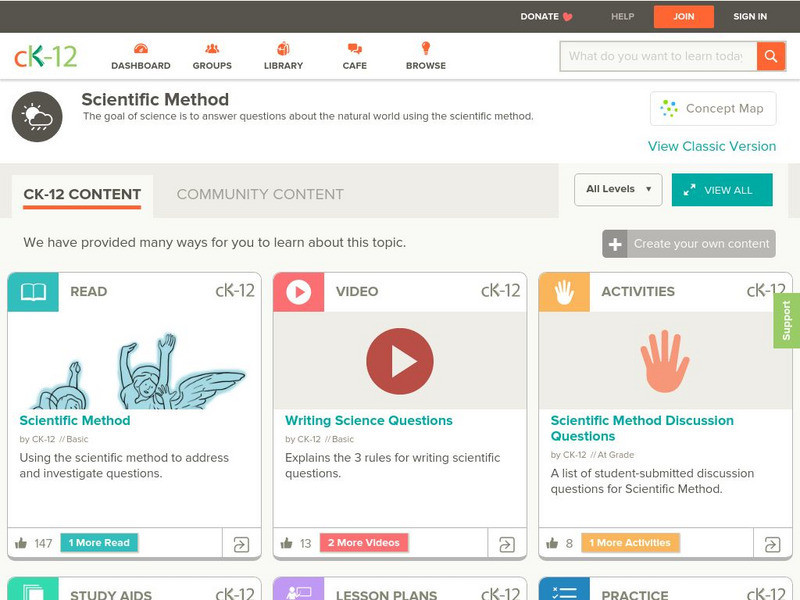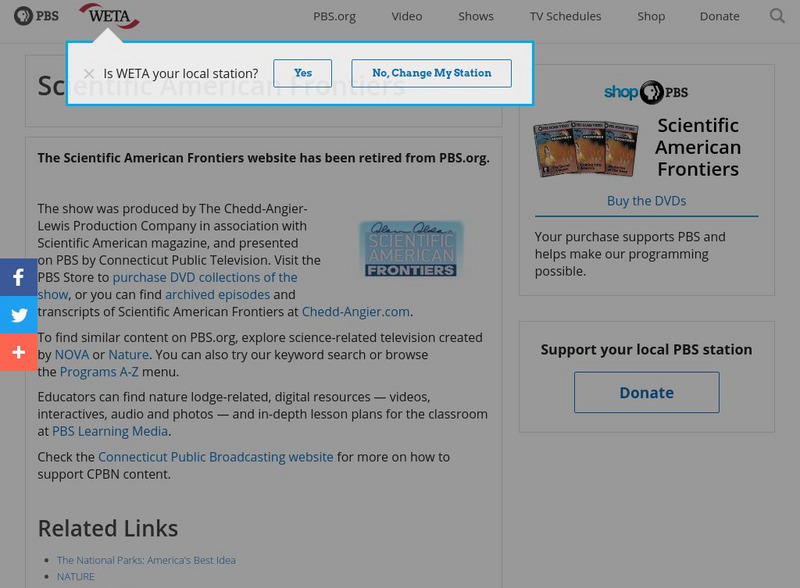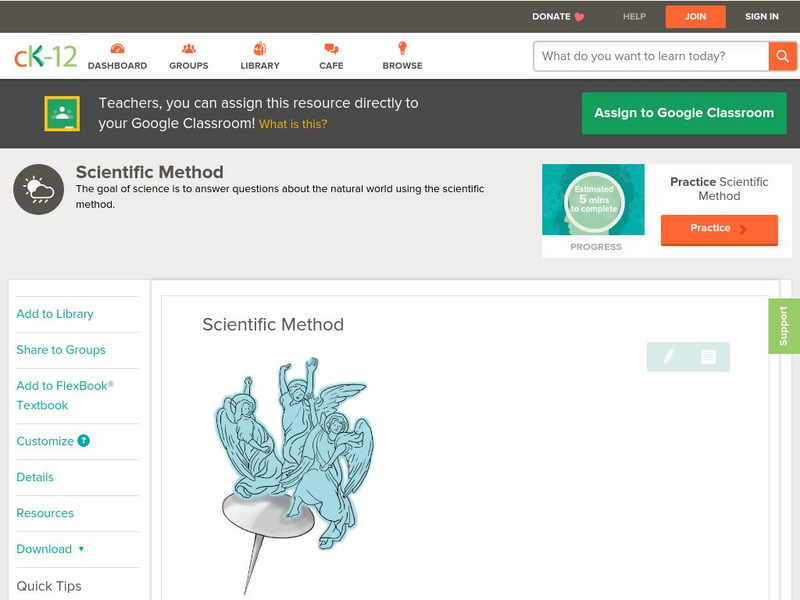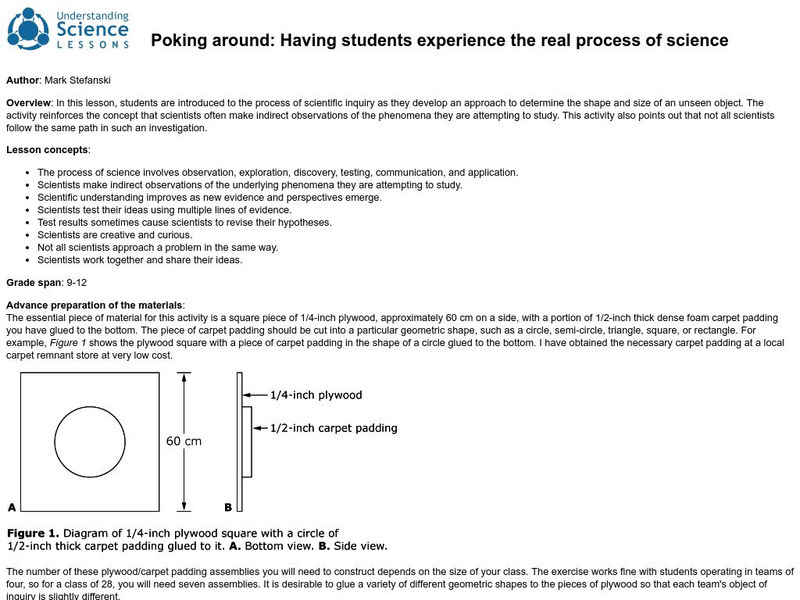Hi, what do you want to do?
Curated OER
Weather Forecasting Basics
Eighth graders analyze weather diagrams and weather maps. In this earth science lesson, 8th graders explain why it is important to know the weather. They complete a handout at the end of the lesson.
Curated OER
NOAA Research Project
Students research any topic relating to the National Oceanic and Atmospheric Administration (NOAA) research cruise that Mrs. Richards be participating in.
Curated OER
The Great Volume Exchanger...or the Magic Matter Maker ®
Students pour water into a "magic" box and examine how it comes out with a much larger volume of water. They, working in small groups, design a volume exchanger and explain its design to the whole class.
University of Washington
Washington U: Model for Conducting Scientific Research
This page outlines the scientific method, step by step.
Smithsonian Institution
Smithsonian Education: Minerals, Crystals, and Gems
Through this series of three lessons, students will gain an understanding of the basics of mineral science. In their investigation they will also work through the scientific process as they practice their observation skills, form...
Vision Learning
Visionlearning: Research Methods: Description in Scientific Research
Specific examples are used show the importance of good description in scientific research since data and numbers are not always available.
CK-12 Foundation
Ck 12: Scientific Method
[Free Registration/Login may be required to access all resource tools.] Instructional videos, grade-level texts, interactive activities, and review material about the scientific method.
ReadWriteThink
Read Write Think: Digging Up Details on Worms: Using Science in an Inquiry Study
A lesson plan based on a study unit of earthworms, using the inquiry model to integrate scientific processes with literacy practices. Instruction plans, related resources, and standards are included.
PBS
Pbs Teachers: Scientific American: About All You Can Eat: Feast or Famine
Investigate the theory that including desert plants such as mesquite and cactus in a diet can help control obesity and diabetes. Design a scientific experiment that will test this hypothesis, using control variables, observation and...
Science Education Resource Center at Carleton College
Serc: Scientific Observation Activity
For this structured exercise, students are asked to observe the world around them and make an observation about any sort of process they see. They then ask a how or why question about their observation, and follow that by three or more...
Climate Literacy
Clean: Time Series: Uncovering the Hidden Processes in Science
In the following exercise, students will review techniques useful to scientists asthey analyze series of data. Learn about scientific observation and try to recognize a pattern or trend within the data.
PBS
Pbs Teachers: Scientific American: Forever Wild? Input and Output
Investigate the scientific principles of biospheres, and observe the effects of biological processes on closed systems.
Science Education Resource Center at Carleton College
Serc: A Data Rich Exercise for Discovering Plate Boundary Processes
This article in the Journal of Geoscience Education describes a classroom exercise based on four world maps containing earthquake, volcano, topographical and seafloor age data. Students participate in this exercise by using a "jigsaw"...
University of California
University of California at Berkeley: Understanding Science: Mystery Tubes
Students collaborate to create a drawing or model of what the inside of a mystery tube looks like. The tube has two ropes attached to a ring inside it. Students must use their powers of observation and deduction to try to understand how...
CK-12 Foundation
Ck 12: Scientific Method (Basic)
[Free Registration/Login may be required to access all resource tools.] This is a basic introduction to the scientifice method that includes links to instructional videos, grade-level texts, interactive activities, and review materials.
National Center for Ecological Analysis and Synthesis, University of California Santa Barbara
Kids Do Ecology: Data and Science
Learn about conducting your own investigation with these tips on following the scientific method. Find out how to state hypothesis, make observations, collect and analyze data, and display data to share results and conclusions of your...
PBS
Pbs Teachers: Scientific American: Animal Einsteins: Who Needs Words, Anyway?
Explore the theory that animals can learn to comprehend abstract concepts by observing to see if specific animal calls are associated with specific actions. Use scientific observation and record-keeping to collect and analyze data.
PBS
Pbs Teachers: Scientific American: Games Machines Play: Streamlined Design
Explore the streamlined shapes of submarines and design an effective hull shape. Observe how streamlining affects a vehicle as it is pulled through a water-filled trough.
TeachEngineering
Teach Engineering: Students as Scientists
This curricular unit contains two lessons that let students actually do the work of scientists as they design their own experiments to answer questions they generate. In the first lesson and its associated activity, students conduct a...
TeachEngineering
Teach Engineering: Corn for Fuel?!
In this activity, students examine how to grow plants the most efficiently. They imagine that they are designing a biofuels production facility and need to know how to efficiently grow plants to use in this facility. As a means of...
Globe
The Globe Program: The Mystery of the Missing Hummingbirds [Pdf]
This story is an interesting way to help students understand the process of migration. It provides teachers with information on how to approach a particular lesson and its easy-to-read content is easily adaptable for grades K-12.
Other
Loughborough Univ.: Young Children's Problem Solving in Design and Technology
This 1997 article from the Journal of Design & Technology Education at Loughborough University in the UK looked at the problem-solving strategies young children use in design and technology tasks, both independently and when working...
Science Education Resource Center at Carleton College
Serc: Mn Step: You Are a Scientist
Students will practice the scientific method as they observe nature and ask questions about it.
University of California
University of California at Berkeley: Understanding Science: Poking Around
Students work in groups to develop an understanding of the size and shape of an object hidden beneath a plywood board, asking questions, testing their reasoning, and drawing conclusions, as scientists do. Students are never permitted to...


























